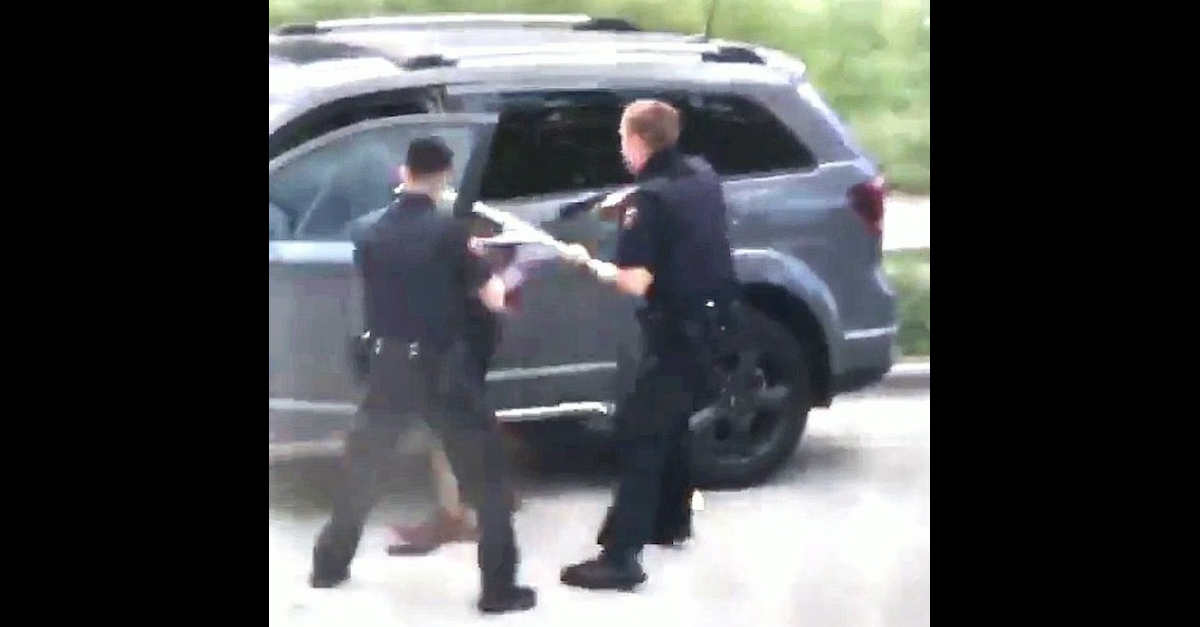
Jacob S. Blake, Jr., the man shot on Aug. 23, 2020 by a Kenosha, Wisconsin police officer, filed a federal civil rights lawsuit on Thursday against the officer who pulled the trigger. That officer, Rusten T. Sheskey, is being sued individually; Sheskey is the only named defendant.
Video of the shooting quickly went viral last August shortly after the shooting occurred.
The 19-page lawsuit describes Blake as an “armed security guard” and “father of three” who was celebrating his son’s eighth birthday when Laquisha Booker, the mother of one of Blake’s children, engaged in an argument with a neighbor. Blake tried to leave with his two sons.
According to the lawsuit’s telling of the events, Booker called the Kenosha Police Department and said, among other things, that she allowed Blake to enter her home even though he “wasn’t supposed to be there.” The lawsuit provides no other details as to what else Booker told the police.
Sheskey and other officers arrived within three minutes. The lawsuit’s narrative of events continued as follows:
Upon arrival, Defendant SHESKEY and other officers approached Plaintiff BLAKE. Without announcing any intention to arrest Plaintiff BLAKE and in the absence of any verbal command to place his hands behind his back to be handcuffed, Defendant SHESKEY grabbed Plaintiff BLAKE by the wrist and began to apply physical force to his arm as he was in the process of placing one of his sons into the back of the SUV.
Believing he was about to be attacked by the police, Plaintiff BLAKE tensed up his arm and attempted to maintain his balance by putting his hands on top of the car.
Immediately, Defendant SHESKEY and other officers began to physically attack Plaintiff BLAKE by placing Plaintiff BLAKE in a headlock, punching and choking him, and shocking him with a taser on three occasions.
As Plaintiff BLAKE struggled to his feet, he retrieved a folding utility knife off the ground that he had previously dropped.
The lawsuit says Blake “began to walk away from the officers” by heading from the passenger side to the driver’s side of the SUV. Officers “followed him with their guns drawn.”
Through a series of paragraphs, the lawsuit says Blake never threatened, struck, ran from, or pointed the knife at the officers.
Again, from the documents:
Once Plaintiff BLAKE reached the driver’s side door of the SUV, he began to open the door with his left hand.
As Plaintiff BLAKE opened the door of the SUV, Defendant SHESKEY grabbed Plaintiff BLAKE’S t-shirt and began to pull him backwards.
Civilians, including a toddler, were nearby. Two of Blake’s children, “ages 5 and 8,” were “in the back seat” of the SUV.
Blake “threw the folding knife onto the floorboard of the SUV,” the lawsuit says, in a movement that was “fully visible” to Sheskey.
Blake attempted to sit in the front seat as Sheskey pulled his tee shirt.
“After Plaintiff BLAKE had thrown the knife to the floor in full view of Defendant SHESKEY, Defendant SHESKEY continued to pull back on the t-shirt of Plaintiff BLAKE with one hand and fired his semi-automatic pistol with the other,” the lawsuit states. “At a time when Plaintiff BLAKE had visibly dropped the folding knife in full view of the officer, Defendant SHESKEY fired a total of seven shots at point blank range.”

Blake remained seated and was putting his feet inside the vehicle as Sheskey continued to pull the trigger. The documents go through a frame by frame analysis of available video of the shooting. It’s alleged that Sheskey turned his head to the left to look at something else while continuing to shoot Blake.
“Throughout the entire course of all seven shots being fired, Plaintiff BLAKE was moving away from – and not toward – Defendant SHESKEY into a seated position, as evinced by the fact that the t-shirt Plaintiff BLAKE was wearing was continuously stretched by Defendant SHESKEY’S grasp of it, even after the seventh shot occurred and Plaintiff BLAKE’S spinal column was severed,” the lawsuit explains.
Sheskey’s gun was loaded with hollow point bullets. They expand when striking an object “in order to inflict the maximum amount of damage to bone an tissue,” the lawsuit alleges. (Hollow point bullets also tend not to pass through one target and into another.)
The lawsuit then alleges that the police may have tried to cover for Sheskey:
After shooting Plaintiff BLAKE, Defendant SHESKEY and other officers who were at the scene were not interviewed by investigators for two, or in some cases, three days, and only after they had conferred extensively with attorneys and union representatives as to what the claimed justification would ultimately be for shooting Plaintiff BLAKE seven times in front of his children.
Defendant SHESKEY and each of the officers refused to have any aspect of the interview recorded and none of their statements given were made under oath. In an effort to conceal material evidence and avoid making any statements that might compromise Defendant SHESKEY and/or the other officer on the scene, some officers deactivated their audio microphones in the aftermath of the shooting and/or cautioned each other to remain silent.
The lawsuit alleges excessive force under 42 U.S.C. § 1983, a federal civil rights statute.
Attorney Patrick Salvi, II is listed as Blake’s lead attorney. A number of others from his office are also on the case. Attorneys Ben Crump and B’Ivory Lamarr are also listed on the document.
Under Wisconsin law, the City of Kenosha is obligated to “pay damages and costs” if Blake wins, the lawsuit points out.
[images via federal court documents]